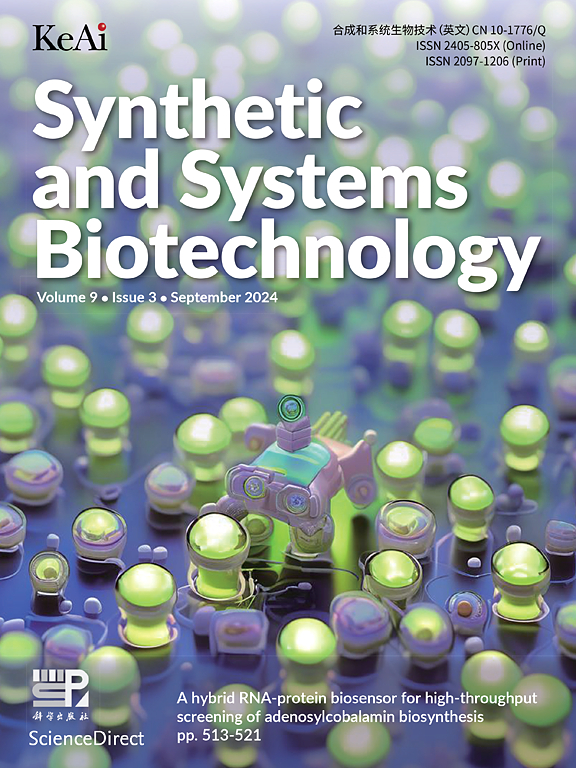对乙醇氧化酶的序列和分类特征评价促进了它们的发现
IF 4.4
2区 生物学
Q1 BIOTECHNOLOGY & APPLIED MICROBIOLOGY
引用次数: 0
摘要
数据技术的最新进展为发现和开发用于绿色合成化学品的新酶提供了巨大的机会。目前的蛋白质数据库主要优先考虑整体序列匹配。支持催化机制和过程的多尺度特征分散在各种数据源中,尚未充分整合以有效地利用酶挖掘。在这项研究中,我们开发了一个序列和分类特征评估驱动的工作流程,以发现可以在大肠杆菌中表达并在体外催化化学反应的酶,并以醇氧化酶(AOX)为例进行了演示,该酶催化甲醇转化为甲醛。利用已报道的21个AOXs数据集构建基于序列长度、结构基序、催化相关残基、结合残基和整体结构等特征的序列评分规则。这些评分规则用于过滤基于hmm的搜索结果,产生357个真核起源候选序列,以85%的序列相似性将其分为6类。选取31个代表所有类别的序列,分两轮进行实验验证。在这些选择的序列中,有19个在大肠杆菌中表达为可溶性蛋白,其中18个可溶性蛋白表现出AOX活性,与预测一致。其中,重组AOX酶活性最高,为8.65±0.29 U/mg,接近天然真核酶的最高活性。与已建立的基于uniprot注释的工作流程相比,基于特征评估的方法获得高活性重组AOX的概率更高(从8.3%提高到19.4%),证明了这种多维特征评估方法在加速发现活性酶方面的效率和潜力。本文章由计算机程序翻译,如有差异,请以英文原文为准。
Sequence and taxonomic feature evaluation facilitated the discovery of alcohol oxidases
Recent advancements in data technology offer immense opportunities for the discovery and development of new enzymes for the green synthesis of chemicals. Current protein databases predominantly prioritize overall sequence matches. The multi-scale features underpinning catalytic mechanisms and processes, which are scattered across various data sources, have not been sufficiently integrated to be effectively utilized in enzyme mining. In this study, we developed a sequence- and taxonomic-feature evaluation driven workflow to discover enzymes that can be expressed in E. coli and catalyze chemical reactions in vitro, using alcohol oxidase (AOX) for demonstration, which catalyzes the conversion of methanol to formaldehyde. A dataset of 21 reported AOXs was used to construct sequence scoring rules based on features, including sequence length, structural motifs, catalytic-related residues, binding residues, and overall structure. These scoring rules were applied to filter the results from HMM-based searches, yielding 357 candidate sequences of eukaryotic origin, which were categorized into six classes at 85 % sequence similarity. Experimental validation was conducted in two rounds on 31 selected sequences representing all classes. Among these selected sequences, 19 were expressed as soluble proteins in E. coli, and 18 of these soluble proteins exhibited AOX activity, as predicted. Notably, the most active recombinant AOX exhibited an activity of 8.65 ± 0.29 U/mg, approaching the highest activity of native eukaryotic enzymes. Compared to the established UniProt-annotation-based workflow, this feature-evaluation-based approach yielded a higher probability of highly active recombinant AOX (from 8.3 % to 19.4 %), demonstrating the efficiency and potential of this multi-dimensional feature evaluation method in accelerating the discovery of active enzymes.
求助全文
通过发布文献求助,成功后即可免费获取论文全文。
去求助
来源期刊

Synthetic and Systems Biotechnology
BIOTECHNOLOGY & APPLIED MICROBIOLOGY-
CiteScore
6.90
自引率
12.50%
发文量
90
审稿时长
67 days
期刊介绍:
Synthetic and Systems Biotechnology aims to promote the communication of original research in synthetic and systems biology, with strong emphasis on applications towards biotechnology. This journal is a quarterly peer-reviewed journal led by Editor-in-Chief Lixin Zhang. The journal publishes high-quality research; focusing on integrative approaches to enable the understanding and design of biological systems, and research to develop the application of systems and synthetic biology to natural systems. This journal will publish Articles, Short notes, Methods, Mini Reviews, Commentary and Conference reviews.
 求助内容:
求助内容: 应助结果提醒方式:
应助结果提醒方式:


